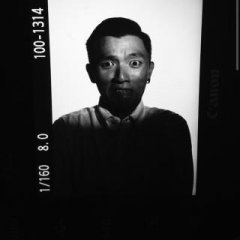Into its 6th iteration, Kyotographie, a photography festival celebrating a mix of works by local and international photographers, focuses on the theme of going UP – an appropriately fitting word encouraging humanity to move UPwards despite the onset of concerning global issues that affect every facet of our lives.
The festival sees a mix of well-curated spaces that either fits into or contrasts with each photographer’s work – Lauren Greenfield’s Generation Wealth exhibition, a culmination of 25 years of photographic inquiry into how our exposure to Hollywood, celebrity and wealth through the media form our own notions of self-worth and appearance through materialistic acquisition and cosmetic modifications, is held at a former printing plant owned by the Kyoto Shimbun, her subject matter of excess standing out again the ghostly, derelict aesthetic of the exhibition space. The former ice factory at Sazanga-Kyu currently holds two main Kyotographie offerings - Gideon Mendez’s Drowning Worlds, a showcase of regions and communities affected by huge floods as a result of global warming, and Spain-born Alberto García-Alix’s Irreductibles series portraits of seemingly inscrutable underworld figures and outcasts. Both the central themes of these two photographers’ works become all the more pronounced with the spaces they are hosted in – visitors will see for themselves why. Within the vicinity, French photographer K-NARF’s Hatarakimono Project displays 80 full length photos along Kyoto’s Chuo market, portraits of everyday Japanese workers offering a stern reminder of these workers are slowly losing their livelihoods to the onset of gentrification and technological automation.

Two important exhibitions from Kyotographie’s lineup this year belong to the often looked-over works of the late Hokkaido-born photographer Masahisa Fukase, and ikebana-artist-turned-photographer Yukio Nakagawa. Fukase, whose seminal Ravens series, heralded as one of the most important photo books, a metaphorical insight into his own mind and the mood surrounding post-war Japan, are in full display here – along with Ravens: Noctambulant Flight, rare colour prints of Ravens and Hibi, a mixture of paint applied to photographic prints. Nakagawa’s exhibition at the Ryosokuin (Kenninji Temple – oldest Zen temple in Kyoto) showcases his avant-garde artistic sensibility as an ikebana artist, who chooses to photograph his work in an attempt to immortalize the short-lived nature of ikebana.
One of the things important to Kyotographie founders Lucille Reyboz and Yusuke Nakanishi was to include African artists for the festival every year, whose works deal with their rich cultural values and own ideals. This year showcases the works of Benin-born Romuald Hazoume, whose On the Road to Porto-Novo exhibition showcases two series of works – one on the harsh realities of petrol-trafficking that keeps Benin’s economy from sinking, and the other quite the opposite: a colourful display of people dressed in costumes, incarnating Egungun ancestral figures in a ritual to bless the masses. Both provide an excellent insight into the history and practices of Benin.
This year also marks the 50th anniversary of civil unrest in France back in 1968, and it is only appropriately fitting that two exhibitions of documentary photographs highlight that theme. Stephen Shames’ Power to the People exhibition is an exploration of the Black Panthers, a political organization borne out of civil unrest in America during the 1960s that challenged police brutality against black people, and installed a myriad of socially beneficial activities such as free food programs for children. Claude Dityvon’s May 1968: Reality dreamed showcase of the protests/strikes in France during aforementioned date, where student-lead demonstrations against such things as American imperialism and capitalism, are an exercise in black-and-white photographic documentation at its finest, the forms and shadows in the pictures exuding a timeless quality.
If one goes around Kyoto during this festival, one would probably chance upon the whimisical image of a young girl balancing herself on a large onigiri as part of Kyotographie 2018’s advertisements – that image belongs to 22-year old Izumi Miyazaki, who first drew attention from her published photos on the internet and on microblogging website Tumblr, and has since accrued fame through her unsual style of photography. Self portraits captured with a sense of Rene-Magritte-surrealism, Miyazaki draws inspiration from daily interactions with life, with food, and with Japanese womanhood.
With the city of Kyoto bearing historical wealth and a diverse range of artistic practices, it only seems fitting that the festival would employ the mix of exhibition spaces infused with deep history/meaning, and the curation of photographers that blend in harmoniously around the central theme of UP. As one enters in and out of each exhibition venue, one can either sense the visual impact, or the contextual influence of each series of work, little by little changing the way one perceives the world around them.































